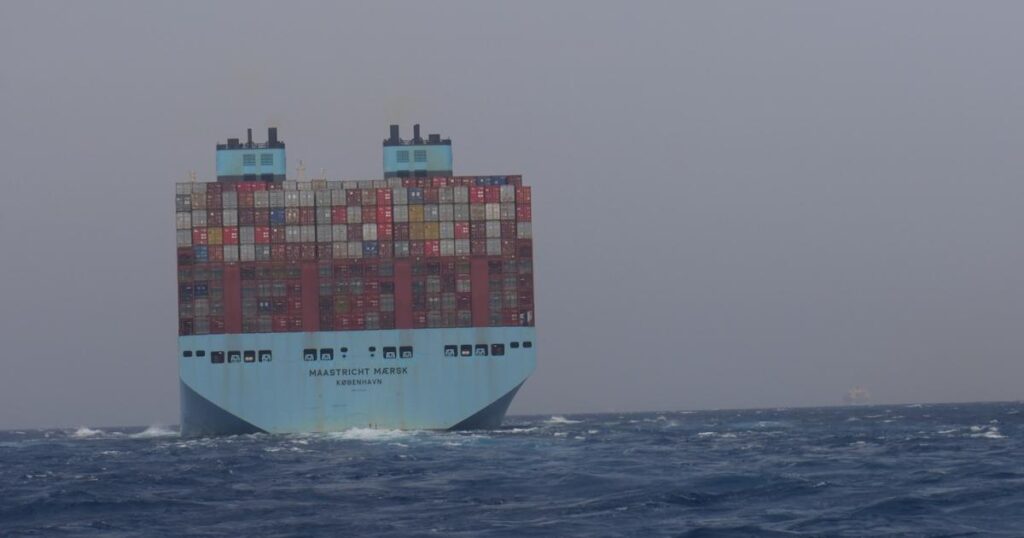How the Red Sea crisis could impede shipping industry climate targets
4 min read
A wave of CO2 emissions caused by diverting commercial shipping around the southern tip of Africa to avoid attacks by Houthi rebels in the Red Sea could jeopardize the industry’s climate goals and damage individual firms’ environmental ratings in the longer term, sector stakeholders have warned.
Recent figures from maritime data firm Sea Intelligence claim diverting hundreds of cargo ships over 4,000 miles and shifting to air freight are increasing CO2 emissions by around 260 percent and 354 percent on routes between Asia and Northern Europe and the Mediterranean, respectively.
Shipping already accounts for almost 3 percent of global emissions, but given sailing distances around the Cape of Good Hope are on average 31 percent and 66 percent longer for routes between Asia and Northern Europe and the Mediterranean, respectively, emissions for the sector are expected to rise sharply in the coming months.
In addition, if vessels seek to compensate for time lost on the longer routes by speeding up, emissions will rise even further, Sea Intelligence warned.
The study also claimed that shipping lines desperate to find additional capacity in response to supply chain issues have deployed smaller, less-fuel efficient vessels on trade routes, which Sea Intelligence suggested could increase emissions by 141 percent for a standard 20-foot container compared those transported on an ultra large container vessel.
“With the escalating Red Sea conflict, it is increasingly clear that we might be in it for the long haul, forcing shipping lines into round-of-Africa routings for the foreseeable future,” the analysis stated. “A direct consequence of this is an increase in CO2 emissions.
“There is no realistic way to mitigate the increased emissions, at the very least those that are due to an increase in sailing distances.”
Threats and attacks have escalated to the point where the likes of Maersk — which alone contributes around 1 percent of transport and logistics emissions every year and almost 0.1 percent of global emissions — MSC, and other shipping giants have halted or rerouted traffic away from one of the world’s most densely packed shipping channels.
According to figures cited by The Guardian, 12 percent of global trade and almost a third of global container traffic, amounting to billions of dollars of traded goods and supplies, passes through the Red Sea every year.
However, as well as hitting firms financially, Julia Salant, general solution manager at sustainability ratings provider EcoVadis, warned the attacks could ultimately scupper the shipping industry’s efforts to hit climate targets.
For example, she warned the International Maritime Organization’s interim goal of reducing shipping industry emissions by at least 20 percent, and ideally 30 percent, by 2030 en route to net zero emissions by 2050 could be under threat.
“The impacts of these attacks could undermine the shipping industry hitting its short-term goal by 2030,” Salent said. “We know that net zero targets cannot be achieved without addressing the supply chain. It is crucial that each company takes action in the supply chain to cascade its greenhouse gas reduction efforts further upstream.
“What we are seeing as best practices is when companies adapt strategies and action plans to the reality of their supply chain — even when there are disruptions like in the Red Sea. To achieve far-reaching decarbonization and build resilience in supply chains, suppliers must be included in the dialogue — while balancing efficiency and collaboration.”
Stuart Gascoigne, global ESG manager at logistics firm Jaggaer, added that given the risk of disruption, such as that seen in the Red Sea, it is more important than ever for companies to have a “strong pulse” on the sustainability status of their suppliers.
“This ability is key to quickly realigning with environmental goals once disruptions stabilize,” he said. “Despite the immediate focus on supply chain challenges, companies must not lose sight of their long-term sustainability commitments. Building resilience and transparency in supplier networks positions organizations to meet decarbonization targets and contribute to a sustainable future.”
Richie Daigle, supply chain “evangelist” at shipment tracking tech firm Tive, added that the knock-on effects of the recent uptick in emissions could significantly influence a company’s image and financial standing in the longer term.
“ESG ratings become increasingly influential in investment decisions — failing to manage higher levels of emissions can result in diminished ratings, eroding investor confidence and potentially restricting access to capital,” he explained. “The emphasis that consumers and stakeholders place on sustainability will only grow, and that means companies with lower ESG ratings will face challenges in maintaining market competitiveness and attracting environmentally conscious consumers.
“Additionally, regulatory scrutiny may intensify, leading to potential fines and legal consequences for non-compliance with emission reduction targets.”
Salant added that the combined effect of shipping cost and carbon footprint spikes stemming from the recent crisis could ultimately nudge companies towards near-shoring opportunities.
“As companies look to take mitigating actions like nearshoring more volume — or sourcing new suppliers on lower-carbon alternative routes, they should also take that opportunity to include sustainability as a key consideration in those sourcing decisions and in the ongoing supplier relationships,” she said.
The shockwaves from the recent attacks on ships in the Red Sea are already being felt geopolitically, but they could also affect corporate decarbonization strategies in the months and years ahead.




